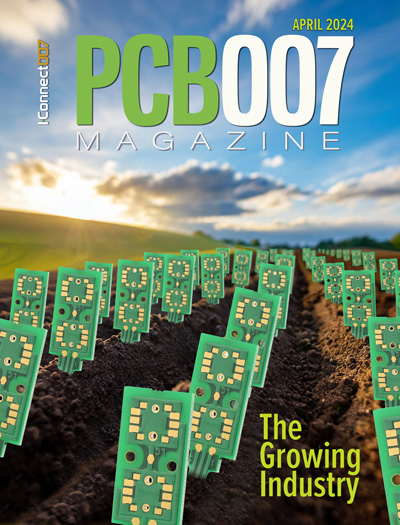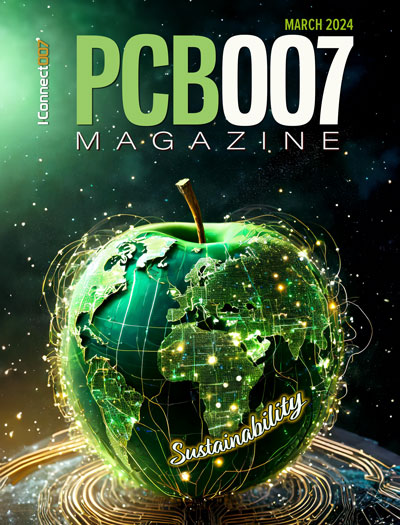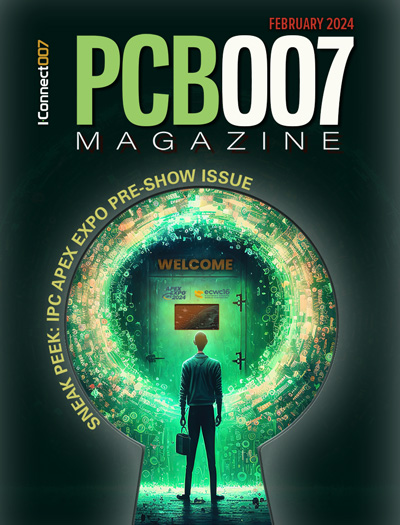-

- News
- Books
Featured Books
- pcb007 Magazine
Latest Issues
Current Issue
The Growing Industry
In this issue of PCB007 Magazine, we talk with leading economic experts, advocacy specialists in Washington, D.C., and PCB company leadership to get a well-rounded picture of what’s happening in the industry today. Don’t miss it.

The Sustainability Issue
Sustainability is one of the most widely used terms in business today, especially for electronics and manufacturing but what does it mean to you? We explore the environmental, business, and economic impacts.

The Fabricator’s Guide to IPC APEX EXPO
This issue previews many of the important events taking place at this year's show and highlights some changes and opportunities. So, buckle up. We are counting down to IPC APEX EXPO 2024.
- Articles
Article Highlights
- Columns
Search Console
- Links
- Events
||| MENU - pcb007 Magazine
A New Facility in India for PCB Fabricator ACI
October 6, 2016 | Barry Matties, I-Connect007Estimated reading time: 17 minutes
I met with Raj Dhanani and Bryan Ricke of Advanced Circuitry International to discuss their growing footprint in India, recent investments in their U.S. facility, and the future of the RF and antenna markets.
Barry Matties: Raj, can you tell a little about ACI and your position there?
Raj Dhanani: Yes, ACI is specialized in RF and microwave circuitry. That's what we've been doing for the last 22+ years, making a lot of the circuit boards out of the RF and microwave materials. I'm the global director of sales and marketing.
Matties: I had a chance to stop by yesterday and chat with you a bit. It was very interesting for many reasons, but one thing that you guys are doing is growing. You have facilities in multiple locations around the world. Can you tell me about your footprint?
Dhanani: We started in 1992 in Atlanta, Georgia. Since then we opened up a facility in early 2000 in Brazil. Just a couple years ago we opened a facility in India to cover a lot of the Asian market. We also just extended another facility here in Atlanta, Georgia, to promote ‘Made in USA’ and support many of our key customers here in the U.S.
Matties: When you make a move to Brazil, that's really specific to a market, I would think. The automotive market, probably.
Dhanani: It's an automotive market as well as an RF market. Being in RF is important as you see all the cellphone and wireless industries expanding and building this infrastructure globally. As our key Tier 1 customers started moving to some of those regions of the world we kind of followed them over there as their key supplier.
Matties: And India, that's pretty interesting because you're early to the game there, I think. I know I talked yesterday about how the associations are always saying, "It's time," but it still feels like we're 10 years away from seeing a real gain in market share there.
Dhanani: Yes, if you want to look at India, let us look at China 10 or 15 years ago. We all remember when they were getting started, and right now you fast forward another 10 or 15 years and they're really getting the big share of the market, mainly in the circuit board industries. Maybe not on basic, standard FR-4 boards, but still in the high-tech side.
Matties: The high-tech side has really engaged in the last five years or so, too.
Dhanani: Correct, and that's what we're saying in India. We've been thinking about going to Asia for a little while. We finally started the facility in India just because we know that we may have some kind of leverage as we grow over there. When we started we thought we were a little too late because all the infrastructure was being built over there locally and what not. Now we're there and of course the demand is there, but a lot of the raw materials, whether it is a chemical or the basic materials to make the circuit boards, is still being imported to India right now.
Matties: I would think the supply chain is limited and the shipment costs play a factor in your ultimate pricing.
Dhanani: It sure does. That's what we are facing right now, but just like anything else, when China started they had the same issues, everything was coming from Europe or the United States. I think as the business grows in India, some of those key suppliers will put up a facility or some bonded warehouses over there to keep the material available.
Matties: How many shops are currently in India? Are you familiar?
Dhanani: In India, I would say there's about eight or 10 shops that are good-sized shops, but in RF it's only about three or four. We call it the Jagat RF Solutions, it's a part of the ACI Group in India, and is one of the state-of-the-art facilities for the wireless infrastructure there.
Matties: Are you looking at customer bases that are there or global customers coming to you and saying they want their boards built in India?
Dhanani: It's both. Definitely we have our key customers over there in India, but this industry is growing also in Africa and in certain parts of the Middle East, and they don't have the supply base over there. I think as the wireless market grows in that part of the world, we will be supplying a lot of the PCBs out of India.
Matties: You're really in a prime position. You have India domestic market share, some global, and you're there years before the competition and you're building relationships.
Dhanani: It definitely put us in a little bit better position, because if you take the first risk you may have a little bit of leverage over there.
Matties: How many employees do you have in India?
Dhanani: In India, we currently have about 80 or 85 employees right now.
Matties: All right, so it's a nice size crew.
Dhanani: It's a nice size, but at the same time, we've only done the first phase of our facility there. By the time we get done with the second and third phases, we're going to have close to about 140,000 square feet and up to 350 to 400 employees.
Matties: You have real vision there and serious investment, too.
Dhanani: Absolutely.
Matties: How's the government been and the business conditions in that regard, with regulations and so on?
Dhanani: I'm glad you asked me that question because that's what everybody's worrying about. When we went to India, even though I was born in India, I had the same worry. You hear about all this and how doing business in a third-world country is not easy. Of course, when we went there, we had our challenges, don't get me wrong, but the good thing is our facility is located inside what’s called the "Special Economic Zone" for electronics, it's called SEZ Electronic Zoning. Basically it’s the zoning that the government created, just like what China did 10 or 15 years ago, to bring in a lot of foreign investment and foreign companies, a lot of which are high-tech companies like ACI. They really want us over there. It kind of made life a little easier for us rather than a lot of the other companies which were just "me too" companies.
Matties: The typical view for India from an American's point of view is what we hear in the media, not a lot of people travel there. They don't have the first-hand knowledge, but we hear about building collapses, corruption, and all other sorts of atrocities that, quite honestly, are scary for people.
Dhanani: It's somewhat scary, but it's changing. India has come a long way. We have a new prime minister, Narendra Modi, and he really wants to change what's going on in India right now. He wants to have a lot of foreign companies coming in there, not just from the business perspective but the local domestic as well. He is prime minister and a lot of the people know that he wants to get the corruption out of there. Right now, that's probably a little bit too much because it's not easy to do in a third-world country.
Matties: Because it reaches all the way to the lowest of levels, and when you're down in the lowest of levels, it hard to root that out.
Dhanani: Absolutely. It's hard to root that out, but it's changing and it's changing rapidly.
Matties: The culture is changing?
Dhanani: Yes, and I see that firsthand. We remember when anything and everything you needed to do in India you had to...
Matties: Grease a palm?
Dhanani: Yep. Now that's not the case. Not all the way, in certain areas, yes, it's going to be there no matter what.
Matties: That's interesting and a great insight. Thank you for sharing that. Let's talk a little bit about your investment in America. There aren’t many people setting up new facilities in America these days. You already had a facility for many years. You started in Duluth, Georgia?
Dhanani: Yes, Duluth. What we're basically doing is a lot of the high-tech parts. We're in RF and microwave, and they're coming back. Some of them are not only coming back, but we're trying to keep it here in the U.S. Because of all the competition and the pricing pressures and everything, some of those things are going abroad and to Asia, but by having the big investment that ACI is trying to do, and is doing right now, we're basically trying to keep the work here in the good ol’ USA. For me personally, I'd rather not go to work anywhere else except here in America.
Matties: But you have your facilities in India, you're set up in Brazil and you're serving those markets. There's, what, 1.3 billion people in India? It's a growing market. Here in the U.S., how much investment did you put into the facility?
Dhanani: We put more than $5 million and, again, we tried to do a lot more semi-automation and automation. One of the things we did in this factory is most of the equipment is brand new equipment that was custom designed the way we wanted. A lot of this IS equipment was made in Italy the way we wanted because with RF boards it's all about consistency. It's not about how fast you can build, how good you can build, and it's not about plus or minus 1-mil or 2-mil circuitries and stuff like that. It's about how much consistency you can have. Every time you do it, it's going to need consistency, that's how all those antennas are going to perform better.
Matties: What was the greatest challenge in setting up a new facility?
Dhanani: I would say the greatest challenge was the timing. We tried to do something real quick, very fast because we had so many orders last year and so much work, and if you don't capitalize on that right now, it's going to go abroad. If you don't do it right now, and right there, right then, then we may lose some of those orders. We didn't want to give them that opportunity.
Page 1 of 2
Suggested Items
AIM Solder’s Dillon Zhu to Present on Ultraminiature Soldering at SMTA China East
04/22/2024 | AIMAIM Solder, a leading global manufacturer of solder assembly materials for the electronics industry, is pleased to announce that Dillon Zhu will present on the topic: Ultraminiature Soldering: Techniques, Technologies, and Standards at SMTA China East. This event is being held at the Shanghai World Expo Exhibition & Convention Center from April 24-25.
AIM to Highlight NC259FPA Ultrafine No Clean Solder Paste at SMTA Wisconsin Expo & Tech Forum
04/18/2024 | AIMAIM Solder, a leading global manufacturer of solder assembly materials for the electronics industry, is pleased to announce its participation in the upcoming SMTA Wisconsin Expo & Tech Forum taking place on May 7 at the Four Points by Sheraton | Milwaukee Airport, in Milwaukee, Wisconsin.
Hentec/RPS Publishes an Essential Guide to Selective Soldering Processing Tech Paper
04/17/2024 | Hentec Industries/RPS AutomationHentec Industries/RPS Automation, a leading manufacturer of selective soldering, lead tinning and solderability test equipment, announces that it has published a technical paper describing the critical process parameters that need to be optimized to ensure optimal results and guarantee the utmost in end-product quality.
Empowering Electronics Assembly: Introducing ALPHA Innolot MXE Alloy
04/16/2024 | MacDermid Alpha Electronics SolutionsIn the rapidly evolving electronics industry, where innovation drives progress, MacDermid Alpha Electronics Solutions is committed to setting a new standard. Today, we are pleased to introduce ALPHA Innolot MXE, a revolutionary alloy meticulously engineered to address the critical needs of enhanced reliability and performance in modern electronic assemblies.
New Book on Low-temperature Soldering Now Available
04/17/2024 | I-Connect007I-Connect007 is pleased to announce that The Printed Circuit Assembler’s Guide to… Low-temperature Soldering, Vol. 2, by subject matter experts at MacDermid Alpha Electronics Solutions, is now available for download.


